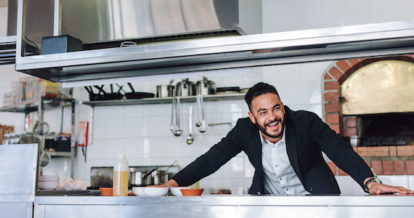In different regions of the world like the Americas, the Middle East, and some countries in Africa, restaurant tipping is an intrinsic part of the dining experience. Gratuities subsidize servers’ wages and, in theory, are commensurate with the quality of service provided.
However, tipping culture is beginning to change in North America due to shifting expectations, technology, and economical concerns. Auto-gratuities and tipping prompts are making it easier for diners to tip, but are they making consumers more generous or resentful?
We talked to restaurant consultant and podcast host Chip Klose to get his insights on the changing state of tipping at restaurants. Keep reading to:
- Meet Chip Klose, restaurant coach, and podcast host
- Learn how tips work at restaurants
- Discover how POS technology can help with tipping at a restaurant
- Get a glimpse into the future of restaurant tipping
Meet Chip Klose: Restaurant Coach and Podcast Host
Chip Klose’s multi-faceted hospitality career has helped him build the expertise he uses in his consulting practice today.
Chip began his career by working his way up in restaurants. After doing everything from washing dishes and folding pizza boxes to bussing and serving, he landed in a role as a maitre d’ at a fine dining restaurant in New York City. Chip was then immersed in the fine dining scene, opening and running restaurants at Michelin-starred institutions and working with James Beard Award winners. One of his most notable projects was opening a Relais & Châteaux in Westchester, New York for actor Richard Gere.
Through his years in the industry, Chip realized that restaurants needed help with marketing. After getting an MBA, Chip started coaching chefs and restaurant operators in marketing, finance, operations, and more to help them build more profitable restaurants.
Alongside his consulting work, Chip hosts the Restaurant Strategy Podcast, for which he shares his expertise and interviews top minds in the industry. It is this podcast and his wealth of experience working with restaurateurs that has given him unique insight into the world of restaurant tipping.
How Do Tips Work at Restaurants?
In the United States, where Chip is based, servers are typically paid a tipped minimum wage that’s below the federal and state minimum wage. With a tipped minimum wage, servers rely on customers to subsidize their wages through tips. If, after gratuities, servers earn less than the untipped minimum wage, employers must make up the difference.
Diners customarily tip between 15% and 20% in the United States, depending on the level of service received. So a diner might give a restaurant tip on the lower end of that range if their expectations weren’t met, or on the higher end (and even more) if the service was great. Because restaurant tipping culture is so strong in the U.S., it’s expected that servers will receive a tip even if they didn’t do a satisfactory job.
Restaurant tip out practices, the distribution of tips to staff, vary from business to business. In some establishments, tips are shared evenly among tipped wage staff. In others, tips are shared by servers who work in the same section. And, in some restaurants, servers get the tips they earned and don’t contribute to a tip pool.
What is the Average Tip Size?
Despite the range in tip sizes, the average tip size in the U.S. is about 20%, according to Chip.
Because 20% is “ what we expect for good service, the expectation is we create great service,” he says.
Although tips can be calculated based on the pre-tax subtotal or after tax has been added to the bill, Chip says he prefers the latter.
How Can POS Technology Help with Restaurant Tipping?
With tipping now such an essential part of the modern dining experience, operators are often looking for ways to improve the tipping process for both staff and customers. Point of sale (POS) systems are helping to fulfill this purpose by simplifying tipping for customers and helping restaurants generate more sales.
Restaurant Tipping Prompts
Restaurants are increasingly using their POS systems to implement tipping prompts. Tipping prompts are most common in transactions that involve a customer-facing display or tableside ordering. While paying, customers see a screen that encourages them to tip by suggesting several (usually three) set percentages, such as 15%, 18%, and 20%.
Tipping prompts can also be found on printed receipts, in which restaurant tip suggestions are calculated so customers don’t have to do the math themselves, and can just select a tip option. POS software generally supports both digital and printed tipping prompts.
Pros of Prompts for Tipping at a Restaurant
Chip is a fan of tipping prompts because they “make tipping easier for the guests. The goal is to make tipping frictionless. [With tipping prompts], we’re taking some of the friction out of that exchange.”
Prompts can also nudge customers to tip more. In an industry that’s currently facing an ongoing labor shortage and high staff turnover rates, bigger tips can be a major incentive for employee retention.
“You’re incentivized to sell more, to work more, and all that. And I think that [earning potential] makes [restaurant work] very attractive for a lot of people,” Chip says.
In other words, prompts let customers “take care of their people,” as Chip says, while still giving them choice.
“At the end of the day the consumer is certainly free to change that number to click another button,” he says.
Cons of Restaurant Tipping Prompts
On the downside, customers may not appreciate the pressure to tip.
Chip says some restaurants start tip prompts at higher percentages, such as 22%, 25%, and 30%. He’s also seen quick service restaurants (QSRs) start to ask for tips, even though they only provide limited service.
With pressure to tip more than the standard amount or in situations in which tipping isn’t generally expected, some customers may leave with a negative impression or simply not leave a tip at all, which defeats the purpose of prompts in the first place.
Upselling
Another way POS technology can help servers earn more tips is through smart upselling features.
According to Chip, the best way for servers to earn more tips isn’t to provide better service, it’s to “drive more revenue.”
“If we can get better at upselling, increasing the check average, focusing on second beverage sales, boosting extras like side dishes, desserts, after dinner drinks, all of those things can provide a significant boost in check average, which then is reflected in the tips,” he says.
Because tips are calculated based on the total check amount, upselling makes a direct impact on gratuities.
“You basically make twenty dollars every time you sell a hundred dollars worth of product. [Servers] can see that there’s a direct correlation,” Chip explains.
POS systems can help with upselling, and therefore tip generation for staff. For example, POS systems with tableside ordering capabilities can prompt servers to upsell with modifiers, such as adding premium toppings to a burger. They can also remind waitstaff to recite specials and suggest a second round of drinks, helping boost the average check size every time.

What is the Future of Restaurant Tipping?
With technology continuously changing the way restaurant staff generate tips, there’s no question that tipping culture is undergoing some dramatic shifts.
In North America, tipping culture is changing due to a number of factors. These are several of the trends affecting the future of tipping at restaurants that Chip has noticed.
Alternatives to Tipping on the Rise
More and more, the hospitality industry is experimenting with restaurant tipping alternatives, like paying servers living wages instead of tipped minimum wages and adding service charges to customers’ bills.
Living Wages
Rather than giving staff tipped wages, some restaurants are paying employees full, living wages so they don’t have to rely on tips. A living wage is a level of income that, in theory, provides employees with enough to live on without putting them at risk of poverty.
While shifting from paying servers a tipped minimum wage of $2.83 per hour in Pennsylvania (for example) to the state’s minimum wage of $7.25 is progress, MIT’s Living Wage Calculator finds that minimum wage is not enough for people to maintain a comfortable standard of living. However, it is a start.
To make up for higher labor costs, restaurants that pay staff a living wage typically compensate by increasing menu prices.
A great example of the living wage trend is famed restaurateur Danny Meyer, who banned tipping at Union Square Hospitality Group and instead paid his staff living wages. Unfortunately, the restaurant group had to reintroduce tipping to offset financial troubles caused by the pandemic. However, the act of introducing a living wage in the first place reflects a major shift in the way restaurateurs are thinking about tipping.
Smaller restaurants, like Juliet in the Boston suburb of Somerville, are also finding great success in paying staff the full minimum wage. Despite the pandemic, Juliet is expanding its original location and its owners are opening a new concept in downtown Boston.
Chip says auto-gratuities and other types of service charges are other popular alternatives to tipping that are changing the restaurant industry.
Service Charges vs. Tips
As Chip notes, service charges are becoming more commonplace in restaurants. So, what’s the difference between service charges vs. tips?
An auto-gratuity is a type of service charge that is counted towards a server’s wages rather than as a tip, which is considered separate income. This restaurant tipping alternative is one way to provide staff with a guaranteed wage, which is important in places where the tipped minimum wage is lower than the standard minimum wage.
Other types of service charges may be able to level out inequalities in pay between the front of the house (which gets paid a lower tipped minimum wage) and the back of the house (which gets paid at least the full minimum wage). Tips are discretionary, and many servers get the short end of the stick with customers who tip poorly. Automatic gratuities can be imposed on diners and billed as service charges, which can alleviate the predicament of poor tipping.
Chip predicts that automatic service charges may cause tipping to disappear altogether over the next five or 10 years.
“What we find is that it’s better for the operator to put an automatic service charge on every check, and then divvy it up in a way that makes sense for their business,” he says.
While the restaurants Chip works with have found success with this model, it should be noted that this should not be construed as legal advice. Because laws about wages, tipping, and service charges vary from state to state, always consult a legal professional before proceeding.
Expectations Around Restaurant Tipping are Changing at QSRs
In addition to widespread changes to tipping culture and processes, Chip has also observed changes among different venue types – specifically at QSRs.
Chip is seeing more and more quick service restaurants implement tip prompts, which he calls “tip-flation.” QSRs are asking for tips to combat the increasing cost of food and labor, to help retain staff without increasing their wages.
However, because tips are widely understood as payment for service, diners may not be on board with tipping at a limited-service or counter-service restaurant where the service is much more limited than at a full service venue.
“Consumers will determine whether they keep putting up with this expected tip,” Chip explains.
Cash is Disappearing for Tip Payouts
One of the final trends that Chip has observed is the way that tips are being paid out to staff. Tips are traditionally paid out in cash and Chip has noticed cash rapidly disappearing from tip payouts.
Part of this shift is due to tools like Kickfin, which are changing how servers receive tips. This cashless tipping software automatically deposits tip payouts into servers’ bank accounts at the end of shifts. The immediate satisfaction of same-day pay helps staff better manage their personal cash flow and ultimately makes people want to stay in the restaurant industry. Plus, payment technologies can prevent legal violations by ensuring employees always get paid on time.
Cashless tip outs also deter robberies, which make things safer for businesses and their staff.
“The less cash we have on hand in the restaurant the better off we are [because there’s] less cash physically in people’s pockets,” Chip explains. “Having left the restaurant late at night many nights, having to walk home, I remember not being thrilled about having hundreds of dollars of cash in my pocket. If I got robbed, what would happen?”
Tip out restaurant technology is also increasing the transparency of tips earned which in turn can boost employee satisfaction and reduce turnover. These tools help employees see how much they earned and what others earned. Servers can trust their employers more when there’s a digital paper trail of their tip earnings.
How, when, and how much you should tip at a restaurant is shifting and will likely continue to undergo major changes. Technology and economical factors are making it easier for customers to tip, while also placing more pressure on them to do so. Only time will tell if tips will be a thing of the past or if they’re here to stay.
Learn how to save money on payment processing fees
Sign up for our free weekly TouchBistro Newsletter







